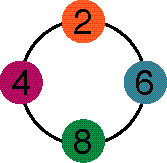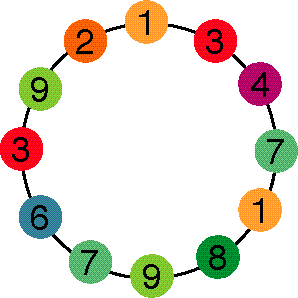The Number Bracelets Game
Contents.
This is a game that lots of kids are playing (or so I've heard).
You only need to be able to add whole numbers to play it,
but there are interesting variations and extensions
for people who like to think about mathematical patterns
(6th graders, high school students, math majors,
graduate students, ...)
The origin of this game, in this form, is an
activity by Marilyn Burns (About Teaching Mathematics, a K-8 Resource,
Math Solutions Publications, 1992.)
Another version can be found
in Joan Cotter's book of
Math Card Games.
Imagine that you have lots of beads, numbered
from 0 through 9, as many as you want of each kind.










Here are the rules for making a number bracelet:
- Pick a first and a second bead. They can have the same number.
- To get the third bead, add the numbers on the
first and second beads. If the sum is more than 9,
just use the last (ones) digit of the sum.
To get the next bead, add the numbers on the
last two beads you used, and use only the ones digit.
So to get the fourth bead, add the numbers on the second and
third beads, and use the ones digit.
Keep going until you get back to the first
and second beads, in that order.
- How long (or short) a bracelet can you make?
Choose 2 and 6 for the first and second beads:

 .
.
The third bead is 2 + 6 = 8 :



To get the fourth bead, add 6 and 8, then use only the ones
digit:
6 + 8 = 14; use 4:




8 + 4 = 12; use 2:





4 + 2 = 6:






But the last two beads are the same as the first two, so
instead of making a long string,
use 2, 6, 8, and 4 in a loop, or bracelet.

Choose 1 and 3 for the first and second beads:

 .
.
The third bead is 1 + 3 = 4 :



3 + 4 = 7:




4 + 7 = 11; use 1:





7 + 1 = 8:






1 + 8 = 9:







8 + 9 = 17; use 7:








9 + 7 = 16; use 6:









7 + 6 = 13; use 3:










6 + 3 = 9:











3 + 9 = 12; use 2:












9 + 2 = 11; use 1:













2 + 1 = 3:














But the last two beads are the same as the first two, so
pop them off and make a bracelet:

Think about these before looking at the answers.
Some of the questions are easier to answer if you work
with other people and make lots of different bracelets.
- How long (or short) a number bracelet can you make?
Answers.
- Will a number bracelet always loop back to the beginning,
or can you have a string of beads that never repeats?
Answers.
- How many different starting pairs of beads are there?
Answers.
- How many different number bracelets are there?
Answers.
- If you start with the same two beads, but in the opposite
order, do you get the same bracelet? Do you get the same
bracelet in reverse?
Answers.
To Extensions and generalizations.
To:
Susan Addington's Home Page at the
Geometry Center ||
Susan Addington's Home Page at
Cal State San Bernardino





















 .
.



















 .
.





































































































